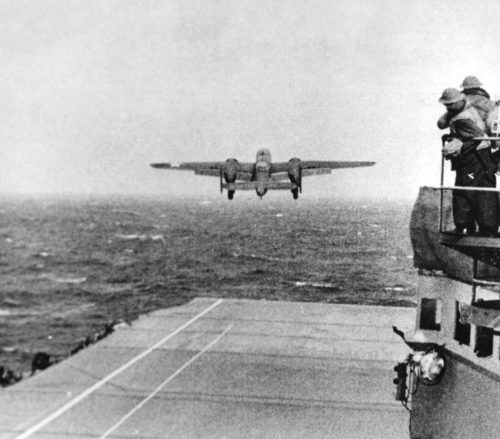April 18 in military history
[This Day in Military History is published daily at OpsLens.com]
1775: Paul Revere and William Dawes begin their famous “midnight ride” from Boston to Lexington, Mass., where they link-up with Samuel Prescott, who rides on to Concord. All three are sounding the alarm – warning town leaders and alerting the militia – that nearly 1,000 British infantrymen, grenadiers, and Royal Marines are advancing from Boston.
1942: At 7:38 a.m. a Japanese patrol vessel spots the task force bearing Lt. Col. James H. “Jimmy” Doolittle and his raiders 650 miles east of Japan. The ship is sunk, but not before her crew can report the position of the American aircraft carriers. Their cover blown, sixteen specially modified B-25 Mitchell bombers have to launch from USS Hornet ten hours earlier than planned.

The crews will not have enough fuel to return to the carrier after the first raid against the Japanese mainland of World War II, so they have been instructed to strike Tokyo and other targets on Honshu, then fly to China and pray they’ll find suitable landing sites or bail out.
The one-way mission will be successful, but all aircraft will be lost. Eleven airmen will be killed or captured. Doolittle will be awarded the Medal of Honor.
1943: Naval intelligence intercepts communications that give them the travel itinerary of Admiral Isoroku Yamamoto – the Commander-in-Chief of the Imperial Japanese Navy, who is touring bases in the South Pacific to boost morale after the United States handily defeats Japan at Guadalcanal.
A select group of pilots scramble from Guadalcanal on their secret mission – personally authorized by President Franklin Roosevelt. The P-38 Lightnings ambush Yamamoto’s “Betty” bomber and its fighter escorts over Bougainville, killing Japan’s top naval officer.
1945: As the Red Army smashes through Berlin’s defenses, 300,000 soldiers in the Ruhr Pocket – mostly old men and young boys – surrender, bringing the total of German prisoners of war to 2 million. Meanwhile, the U.S. Ninth Army captures Magdeburg, while 1,000 British bombers turn the island naval fortress of Heligoland into a cratered moonscape.
Nazi Germany is on the ropes.
Across the globe, famed war correspondent Ernie Pyle is killed by a Japanese machine gun two days after landing with the 77th Infantry Division on Ie Shima, a small island northwest of Okinawa. President Harry Truman states, “No man in this war has so well told the story of the American fighting man as American fighting men wanted it told.” Pyle is posthumously awarded the Purple Heart – rarely awarded to civilians.
1983: A Hezbollah suicide bomber crashes a truck carrying 2,000 lbs of explosives into the U.S. Embassy in Beirut, Lebanon, setting off a blast that kills 63 people. Among the fallen are 17 Americans, including the CIA’s station chief Kenneth Haas, his deputy, the agency’s regional director, and four service members.
Haas is replaced by former Army Special Forces officer William F. Buckley, who will be kidnapped and killed by Hezbollah the following year.